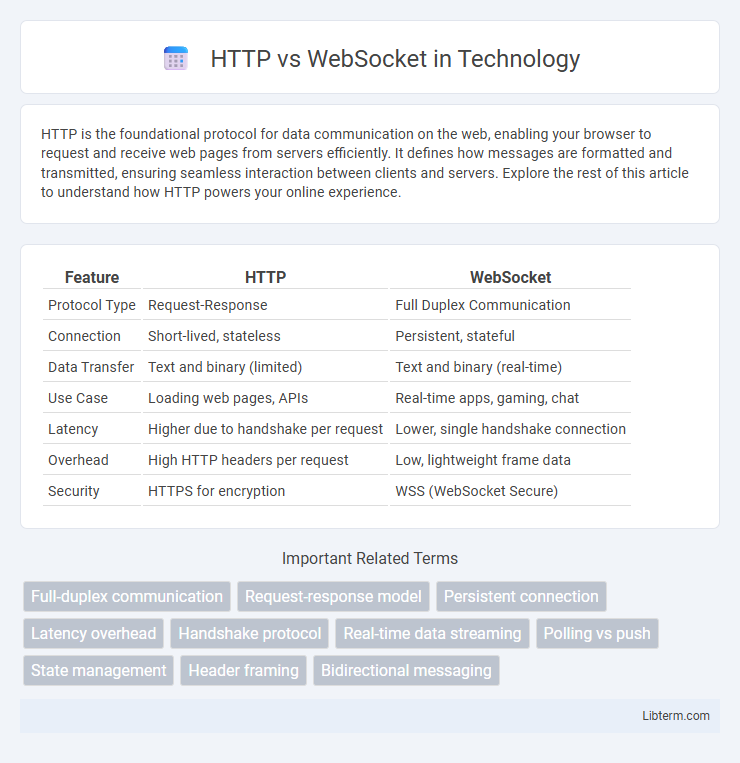HTTP is the foundational protocol for data communication on the web, enabling your browser to request and receive web pages from servers efficiently. It defines how messages are formatted and transmitted, ensuring seamless interaction between clients and servers. Explore the rest of this article to understand how HTTP powers your online experience.
Table of Comparison
| Feature | HTTP | WebSocket |
|---|---|---|
| Protocol Type | Request-Response | Full Duplex Communication |
| Connection | Short-lived, stateless | Persistent, stateful |
| Data Transfer | Text and binary (limited) | Text and binary (real-time) |
| Use Case | Loading web pages, APIs | Real-time apps, gaming, chat |
| Latency | Higher due to handshake per request | Lower, single handshake connection |
| Overhead | High HTTP headers per request | Low, lightweight frame data |
| Security | HTTPS for encryption | WSS (WebSocket Secure) |
Introduction to HTTP and WebSocket
HTTP operates as a stateless protocol primarily designed for request-response communication between clients and servers, ideal for loading web pages and APIs. WebSocket establishes a persistent, full-duplex connection enabling continuous, real-time data exchange with lower latency, suitable for applications like chat or live updates. Both protocols run over TCP but serve different interaction models: HTTP for discrete transactions and WebSocket for ongoing bidirectional communication.
Core Concepts: How HTTP Works
HTTP operates as a stateless protocol where client-server communication occurs through request-response cycles, with each request initiating a new connection. Clients send HTTP methods like GET or POST to request resources, and servers respond with status codes and data payloads. This stateless nature requires repeated headers and metadata in each transaction, impacting efficiency for real-time applications.
Core Concepts: How WebSocket Works
WebSocket establishes a persistent, full-duplex communication channel over a single TCP connection, enabling real-time data exchange between client and server without the overhead of repeated HTTP requests. The protocol begins with an HTTP handshake, upgrading the connection to WebSocket, after which both parties can send and receive messages independently. This mechanism minimizes latency and resource consumption compared to traditional HTTP polling or long-polling methods.
Key Differences Between HTTP and WebSocket
HTTP operates as a stateless, request-response protocol primarily used for fetching documents and resources, while WebSocket establishes a persistent, full-duplex communication channel enabling real-time data exchange between client and server. HTTP involves multiple connections with higher latency due to opening and closing connections per request, whereas WebSocket maintains a single open connection, reducing overhead and enabling low-latency interactions. WebSocket is ideal for applications requiring instant updates like gaming, chat, and live feeds, whereas HTTP suits traditional transaction-based web browsing and API requests.
Performance Comparison: HTTP vs WebSocket
WebSocket outperforms HTTP in real-time data transfer by maintaining a persistent connection that eliminates the overhead of repeated handshakes and HTTP headers, resulting in lower latency and reduced bandwidth usage. HTTP relies on a request-response model, causing delays in bidirectional communication, whereas WebSocket enables full-duplex communication, supporting faster and more efficient interactions. Benchmark studies indicate WebSocket can achieve up to 10 times faster message exchange rates in scenarios requiring continuous data streams, such as live chat or online gaming.
Use Cases: When to Choose HTTP
HTTP is ideal for client-server communication where requests are infrequent and stateless, such as loading web pages, submitting forms, or fetching API data. Applications requiring simple request-response interactions with low latency, like RESTful services or traditional websites, benefit from HTTP's widespread support and caching mechanisms. Use HTTP when real-time communication or persistent connections are unnecessary, ensuring scalability and compatibility across diverse platforms.
Use Cases: When to Choose WebSocket
WebSocket excels in real-time applications requiring low latency and persistent, bidirectional communication, such as online gaming, live chat, and stock market feeds. HTTP remains suitable for traditional request-response interactions like web page loading, form submissions, and RESTful APIs. Choose WebSocket when continuous data exchange and immediate server updates are essential for user experience and system performance.
Security Considerations for HTTP and WebSocket
HTTP relies on TLS encryption (HTTPS) to secure data in transit, but remains vulnerable to man-in-the-middle attacks, request forgery, and session hijacking if not properly configured. WebSocket inherits TLS security when using WSS, yet poses additional risks such as persistent connection exploitation and increased attack surface for denial-of-service (DoS) attacks. Both protocols require rigorous implementation of authentication, authorization, and input validation to mitigate security threats effectively.
Scalability and Resource Management
HTTP is stateless, which simplifies scalability by allowing load balancers to distribute requests across multiple servers without maintaining session information, but it incurs overhead from repeatedly opening and closing TCP connections. WebSocket maintains persistent connections, reducing latency and improving real-time data transfer efficiency, yet requires servers to manage a larger number of simultaneous open connections, which can challenge resource allocation and horizontal scaling. Effective resource management in WebSocket implementations often leverages event-driven architectures and optimized connection handling to balance scalability with low-latency communication.
Choosing the Right Protocol for Your Application
HTTP suits scenarios requiring stateless, request-response communication such as standard web page loading or RESTful APIs. WebSocket offers persistent, full-duplex connections ideal for real-time applications like chat systems, live streaming, or multiplayer gaming where low latency and continuous data exchange are critical. Evaluating factors like message frequency, latency tolerance, and data flow direction ensures the best protocol aligns with application performance and scalability needs.
HTTP Infographic

 libterm.com
libterm.com